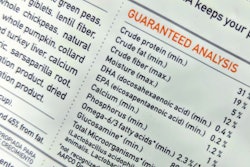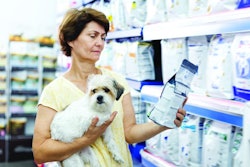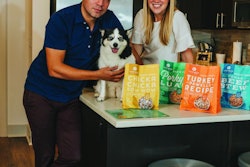
The more sophisticated pet-oriented Asian countries in 2022 will continue to see the adaption of unique pet food ingredients and flavor profiles designed to extend the health and taste benefits for the region's pandemic-weary pets.
Native ingredients make for novel pet food formulations
From East to Southeast Asia, specialized pet food makers are going deeper into local pantries and endemic gardens for suitable ingredients that will uniquely highlight flavors of their homes. For example, it's now commonplace for the pampered pet dogs and cats in Singapore to tuck into a bowl of Nasi Lemak, an all-time local favorite which is actually the national dish of Malaysia. Made by human-grade fresh pet food company PetCubes, the nasi lemak pet food version contains the dish's traditional ingredients such as roasted peanuts, brown rice, pandan leaves and coconut milk cooked with any type of meat.
In Japan, dogs and cats can now have a sprinkling of furikake to top their meals. Furikake is a type of Japanese powdered condiment used to garnish rice, meat or vegetables. It's usually made of dried nori (seaweed), toasted sesame seeds, salt, sugar and dried fish, eggs or vegetables. An interpretation of furikake for pets called Hitosaji no Maho is based on fish peptides and was made available in 2021 from a 12th-century artisanal kamaboko (fish cake) maker outside Tokyo.
Local dishes made for pets excite pet owners
Those who are reinventing local dishes to be suitable for pets are finding the market receptive to their ideas. This is because a lot of people can't resist sharing their meals with their pets and having these new types of “human grade” pet food allows them to give something very close to what they're having, minus the salt and other ingredients unfit for pets.
By creating a pet-safe nasi lemak, PetCubes sees Singaporeans and their pets having a more enjoyable dining time together when eating something alike. PetCubes said it is their mission to revamp local dishes with pets' health and quality of life in mind.
A 320g pack costs almost US$6 and contains chicken parts and fresh yellowstripe scad cooked in nasi lemak sauce. PetCubes claims the formula exceeds U.S. pet food standards and has immune-boosting compounds such as carotenoids and antioxidants, as well as herbs good for the brain and liver.
Artisanal Japanese food company Suzuhiro Kamaboko also thought about pets' longevity when they developed their furikake for pets. The 150-year-old company uses meat from white fish to provide peptides that promote digestion and absorption of nutrients. Suitable for any dog or cat that is weaned, the Hitosaji no Maho furikake supports the health of dogs and cats from their critical growth period to their senior years when protein absorption slows down.
“We want pets — friends and close companions to many people — to live a long and healthy life with fish protein,” the company said.
They claim dogs' and cats' daily nutritional intake gets boosted by sprinkling the right amount of Hitosaji no Majo over their regular food. Sourcing the fish furikake, however, isn't that simple as it is sold only at the Suzuhiro Kamaboko castle and its website. Prices start at about US$17 for a 120g pouch.
For another trendsetting pet food maker in Singapore, the excitement over unique pet food translates to products often being sold out.
“Customers tell me that they get confused with the food I sell sometimes,” said the entrepreneur behind human-grade, natural pet treat company Ola's Favorites. “Is it for furkids or humans? I wanted to say both, but just a reminder that these are actually pet snacks.”
One of Ola's best-selling products is the Ba Zhang (or machang), a traditional Chinese glutinous rice cake stuffed with different fillings and wrapped in bamboo leaves. A piece of Ola's ba zhang for dogs contains crispy pork, venison tendons, quail eggs and pumpkin on sticky rice shaped like a giant pyramid, good enough for four dogs.
On special occasions, the one-woman-business also makes Shanghai-style mooncakes for dogs with yellowtail fish topped with siobak (pork crackling) and bak hu (pork floss).
Roots and crops for pets' enriched “culinary” dining pleasure
Meanwhile, a closer look at certain plants across Asia is unearthing new pet food ideas. Take ube and durian, as examples. Ube a purple tuber and durian a potent-smelling fruit that are both abundant in the Philippines and are safe to be consumed by pets. Ube can be served as boiled treats or dried crisps, which should be easy enough to do at home. Some pet treat companies use ube to add natural color to their products.
As for durian, Dr. Susanna Santhiram–Hofherr of Asia Paws veterinary clinic guarantees that durian is a good natural treat for dogs as it contains lots of vitamins and minerals. But the so-called king of fruits also packs a rich amount of calories from its high sugar and carbohydrate content, so dogs must nibble on it moderately.
Recently, PetCubes also added ashwagandha root and spirulina, considered to be superfoods, to their line of gently cooked and raw pet food. Ashwagandha is a shrub that's native to India and Southeast Asia. The roots and leaves can be turned into tea or powder extract and used to reduce stress, blood sugar levels and inflammation. Spirulina is a blue-green algae that exhibits similar nutritional and healing properties to ashwagandha.
The Asian market may also see more of tofu-based pet food in 2022. Tofu, or bean curd from soybeans, can easily be added as-is to pet's meals or cooked with other pet-safe vegetables and proteins. Fresh pet food company Petokoto from Japan is releasing “Soy Meat,” which is soybean with pumpkin, carrot and komatsuna (Japanese mustard spinach) to create a meat-like consistency.
Variety is the spice of life and it's important to have, especially with food, as health quarantines continue to keep humans and pets holed up at home. Pushing the pet food envelope closer to what people actually eat should make 2022 an exciting year for pet feeding. This is also going to be a challenging special niche where foreign pet food brands might find it harder to compete against the locals.
Global pet food production up 8.2% in 2021, Asia led
www.PetfoodIndustry.com/articles/10971
Asian pet food news 2021: insects, politics, expansion














